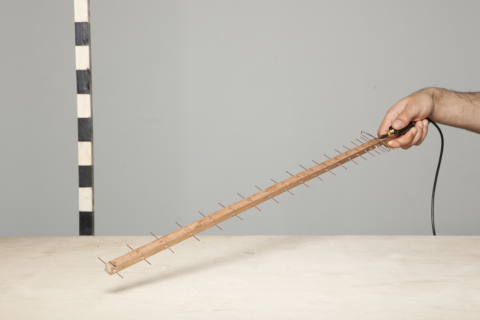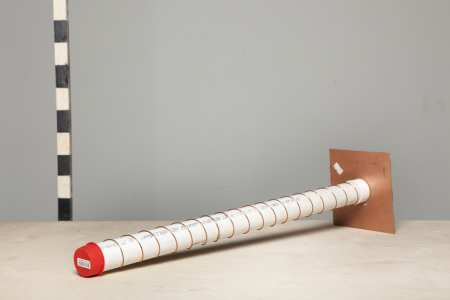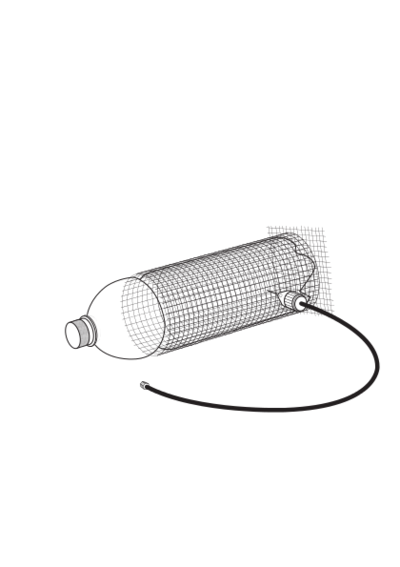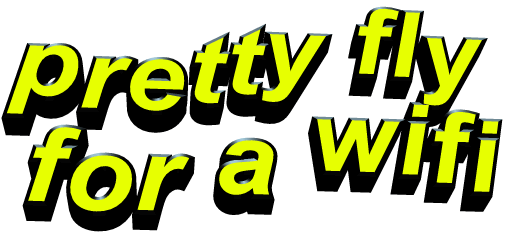Pretty Fly for a Wifi: Difference between revisions
Roelroscama (talk | contribs) No edit summary |
Roelroscama (talk | contribs) No edit summary |
||
| Line 10: | Line 10: | ||
Pretty Fly For A Wifi is an overview of different self-made WIFI antennas. It is a combination of pots and pans, dishes and cans through which people from around the world give shape to their collective dream of making an alternative internet. Each of these objects tells part of the story of individuals and groups, who each in their own way try to reconfigure the internet’s infrastructure to achieve this goal. For this project I built, tested and documented these antennas and in the process revisited their histories, origins and uses. | Pretty Fly For A Wifi is an overview of different self-made WIFI antennas. It is a combination of pots and pans, dishes and cans through which people from around the world give shape to their collective dream of making an alternative internet. Each of these objects tells part of the story of individuals and groups, who each in their own way try to reconfigure the internet’s infrastructure to achieve this goal. For this project I built, tested and documented these antennas and in the process revisited their histories, origins and uses. | ||
[[File:Pretty_fly_helical.png | 450px | thumb | right | WI-FI (a play on Hi-Fi) is the trademark for IEE 802.11 standard of wireless data exchange on the 2450 megahertz radio band. Since its introduction in 2000 the WI-FI brand has become synonymous with wireless computer networks, a more generic term to use is WLAN. ]][[File:Pretty_fly_wok.png | 500 px | thumb | left | Shortly after the commercial introduction of WI-FI equipment the idea of community wireless networks emerged. These grassroots organizations use WI-FI to build alternative network infrastructures, often on a peer to peer basis and without the need for costly wires. Such network infrastructures can be found on rooftops, balconies and windowsills and can cover large distances by broadcasting from building to building. ]][[File:Pretty_fly_cantenna.png | 600 px | thumb | right | Wireless community networks serve a variety of purposes, sometimes to provide broadband connections where there are none, to make censorship free alternatives to the internet or to share the costs of a single internet connection. All these networks use cheap and readily available consumer electronics and are thus limited to a range of around 30 meters. To increase their range, these networks often rely on self-made antennas to make more distant connections possible. With the use of self-made antennas people have able to connect machines that are tens of kilometers apart. ]][[File:Pretty_fly_yagi.png | 480 px | thumb | left | Through these self-made antennas people from around the world have given shape to computer networks that reflect their personal ideals. With a wavelength of around 12 centimeters, antennas for 2.4Ghz WI-FI have dimensions that are literally handy. As a consequence, these antennas are both clever appropriations and accidental convergences of the shapes and sizes of household objects that happen to accommodate the size of the 2.4Ghz radio wave. ]] | [[File:Pretty_fly_helical.png | 450px | thumb | right | WI-FI (a play on Hi-Fi) is the trademark for IEE 802.11 standard of wireless data exchange on the 2450 megahertz radio band. Since its introduction in 2000 the WI-FI brand has become synonymous with wireless computer networks, a more generic term to use is WLAN. ]][[File:Pretty_fly_wok.png | 500 px | thumb | left | Shortly after the commercial introduction of WI-FI equipment the idea of community wireless networks emerged. These grassroots organizations use WI-FI to build alternative network infrastructures, often on a peer to peer basis and without the need for costly wires. Such network infrastructures can be found on rooftops, balconies and windowsills and can cover large distances by broadcasting from building to building. ]][[File:Pretty_fly_cantenna.png | 600 px | thumb | right | Wireless community networks serve a variety of purposes, sometimes to provide broadband connections where there are none, to make censorship free alternatives to the internet or to share the costs of a single internet connection. All these networks use cheap and readily available consumer electronics and are thus limited to a range of around 30 meters. To increase their range, these networks often rely on self-made antennas to make more distant connections possible. With the use of self-made antennas people have able to connect machines that are tens of kilometers apart. ]][[File:Pretty_fly_yagi.png | 480 px | thumb | left | Through these self-made antennas people from around the world have given shape to computer networks that reflect their personal ideals. With a wavelength of around 12 centimeters, antennas for 2.4Ghz WI-FI have dimensions that are literally handy. As a consequence, these antennas are both clever appropriations and accidental convergences of the shapes and sizes of household objects that happen to accommodate the size of the 2.4Ghz radio wave. ]] | ||
[[File:Anjovisbiquad.svg | thumb | 400 px | Biquad antenna based on an anjovis tin. | [[File:Anjovisbiquad.svg | thumb | 400 px | Biquad antenna based on an anjovis tin. Illustrations by [[User:Lidia.Pereira | Lídia Pereira]] ]] | ||
[[File:Bottlemesh.svg | thumb | 400 px| left | Bottle and wire mesh antenna. Made by Mali.Geekcorps, a French NGO to help connect remote Malian villages to the internet ]] | |||
[[File:Pretty_fly_gif.gif]] | [[File:Pretty_fly_gif.gif]] | ||
Revision as of 08:52, 24 June 2014
| Student | Roel Roscam Abbing |
|---|---|
| Graduation Year | |
| Featured image | File:File:Pretty Fly Tent.jpeg |
| Work Description | |
| Bio | Roel Roscam Abbing (1990, NL) is an artist and researcher who spent too much time on his computer. Out of that came a collaborative practice in which he likes to deal with the cultures and issues surrounding networked computation. Currently his topics of interest include the internet's infrastructure, wireless community networks and DIY techniques. |
| URL | http://roelof.info |
Pretty Fly For A Wifi
Pretty Fly For A Wifi is an overview of different self-made WIFI antennas. It is a combination of pots and pans, dishes and cans through which people from around the world give shape to their collective dream of making an alternative internet. Each of these objects tells part of the story of individuals and groups, who each in their own way try to reconfigure the internet’s infrastructure to achieve this goal. For this project I built, tested and documented these antennas and in the process revisited their histories, origins and uses.

Shortly after the commercial introduction of WI-FI equipment the idea of community wireless networks emerged. These grassroots organizations use WI-FI to build alternative network infrastructures, often on a peer to peer basis and without the need for costly wires. Such network infrastructures can be found on rooftops, balconies and windowsills and can cover large distances by broadcasting from building to building.

Wireless community networks serve a variety of purposes, sometimes to provide broadband connections where there are none, to make censorship free alternatives to the internet or to share the costs of a single internet connection. All these networks use cheap and readily available consumer electronics and are thus limited to a range of around 30 meters. To increase their range, these networks often rely on self-made antennas to make more distant connections possible. With the use of self-made antennas people have able to connect machines that are tens of kilometers apart.

Through these self-made antennas people from around the world have given shape to computer networks that reflect their personal ideals. With a wavelength of around 12 centimeters, antennas for 2.4Ghz WI-FI have dimensions that are literally handy. As a consequence, these antennas are both clever appropriations and accidental convergences of the shapes and sizes of household objects that happen to accommodate the size of the 2.4Ghz radio wave.

Biquad antenna based on an anjovis tin. Illustrations by Lídia Pereira



